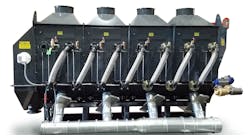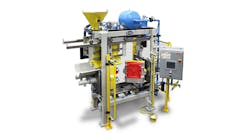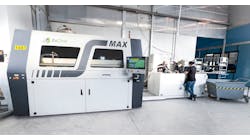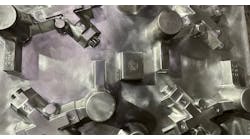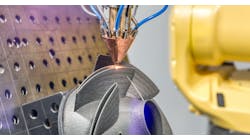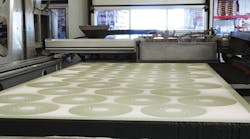Latest from Molds/Cores
To a great extent, metalcasting is problem solving, and as metalcasting technology advances the problems that are solved grow more complex – overcoming the limits of time, space, and cost. The emergence of 3D printing as an effective production-scale process is expanding foundries’ potential to address customers’ needs, solving problems in new ways.
Producing sand molds and cores is the most notable recent development in foundries’ incorporation of 3D printing, and much of that is that has been the work of Voxeljet Technology GmbH. It supplies industrial-scale 3D printing systems and operates one of Europe’s largest service centers producing metalcasting molds and cores on demand.
Recently, one of Voxeljet’s customers, the Schmolz + Bickenbach Guss Gruppe, ordered a VX1000 large-format, 3D printer (with a build space of 1,060x600x500 mm), and will introduce the process for mold production at one of its specialty steel foundries.
The problem-solving dimension of 3D printing in mold production emerged recently in a project involving Wolfensberger AG, a steel foundry in Switzerland, and Turbal AG, a manufacturer of turbine systems, and a small hospital in Ethiopia where a defective Francis wheel for a critical water turbine was impeding the availability of electricity.
The effort to produce a new wheel for the Ethiopian clinic was led by Turbal, a family-owned company in Switzerland. Solving the clinic’s problem was made difficult because conventional production of turbine wheels is highly detailed, labor-intensive, and expensive process because it requires manual production of several sand core segments and complicated undercuts. Voxeljet's 3D printing technology offered a well-designed, fast, and cost-effective alternative.
"Once we heard about the problem, we immediately decided to help,” explained Dr. Ingo Ederer, CEO of Voxeljet Technology GmbH. “Our 3D print technology is virtually predestined for cases such as these. The state-of-the-art printing equipment at our service center allows for economical and tool-less production of high-quality sand molds and cores for metalcasting based on CAD data, even for a batch size of one. Producing a sand core for the wheel is a routine undertaking for us.”
Once the necessary CAD data for the wheel was available, Voxeljet started the process of producing the flow-carrying interior for the Francis wheel. In this step, forming the monoblock sand core is a fully automated process using 3D printing. It replaces several sequential, manual processes for producing core segments. In contrast to standard mold manufacturing, for which producing model plates or core boxes may can take several weeks, 3D printing makes it possible to print smaller sand molds in as little as a few hours.
Building the Mold
The 250-mm mold for the Francis wheel was built in layers over a period of almost five hours. Precision is a factor: the process has an accuracy of 0.2 millimeters in thexand Y directions, which is setting new performance standards. In principle, Voxeljet's large-format printers can produce molds of particle material in dimensions of 4x2x1 meters.
The molds are created without cumbersome and expensive mold set-ups, and the production process is fully automated. It is based solely on CAD data, using the layer building method, which consists of repeated application of 300-micrometer thick quartz sand layers that are selectively glued together with a binder using the print head of the system.
This method offers significant production-related advantages that affect quality, production targets, and profitability equally. In this case, 3D printing resulted in higher component accuracy, a significant reduction in subsequent machining, and excellent surface quality and contour precision.
After the printing process is complete, the mold has only to be unpacked and cleaned of excess sand, and it is finished. The molds are easy to handle, so they can be transported to the foundry easily. Due to their low binder content (1.2%) and a pressure of 220N/cm², the sand cores are comparable to those produced in conventional series production. They can be used immediately for further processing and are ready for casting.
"In this case, we decided on a combination of a 3D-printed sand core for the complicated turbine geometry and a conventionally produced exterior mold. This means that we use the advantage of 3D printing where it pays off the most,” Ederer said, “for the production of the complicated interior (of the model). Instead of many individual core segments that are strung together, the mono sand core impresses with higher component accuracy, smaller tolerances, and fewer cleaning requirements, and does away with the need for many core separation devices.”
In most cases, it pays to produce both the interior as well as the exterior mold using the 3D printing method, Voxeljet noted. In each case, the production numbers and individual design details that will determine how the exterior mold should be produced.
The Wolfensberger steel foundry, which is increasing its use of Voxeljet sand molds for producing complex cast part prototypes, also was impressed by the quality of the 3D prints in this project. The cast impressed Turbal AG, too. And, the companies’ efforts restored the electricity production at the clinic in Ethiopia.
"In our opinion, non-bureaucratic, direct-help projects such as these are very effective, and also ensure that help goes exactly where it is needed. Voxeljet was pleased to be able to make a meaningful contribution to a meaningful project',” Ederer concluded.




